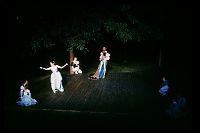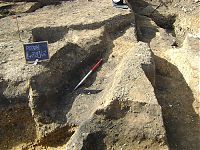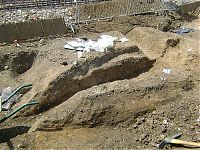A Midsummer Night’s Dream
- By: Will Clarke |
- Jul 30, 2008
- Share
- del.icio.us

Ok so my name’s not Puck… Prescot Street is not an enchanted forest… neither is it the realm of the fairies (although, Mr…. who lives near by…is a bit odd) and Guy doesn’t ask us to dig by moonlight. My first week, nevertheless, coincided with Mid-Summer, and just like the plot of a Midsummer Night’s Dream, wedding plans are afoot for more than one of our team (oops hope that’s not a secret)… and me, well I was having a dream start, experiencing the sort of fun and inquiry I don’t normally find in commercial archaeology. Not for one moment have I felt like what Puck would describe as “a rude mechanical” although, admittedly, when I’m digging I look like one.
Although excavating Roman burials maybe fascinating, what would really grab my interest is a Roman building. So I had more than just a passing interest in the discovery in Zone 2 of a large tegula tile in the fill of pit Context: 1324 I was digging with Greg, and the patches of opus signinum mortar (easy to spot because of its pink-red colouration) amongst deposits of a nearby pit Context: 1281 I was digging with Liz.
But it gets better… much better, because as I write excavation has commenced in Zone 3, south east of these pits, where we may well have uncovered the remains of a building. A structure in a Roman cemetery could well be either of a columbarium housing the cremated remains of individuals unable to afford the costs of a private burial, or of a mausoleum lying at the other end of social spectrum, marking the burial site of a very wealthy individual.
The evidence at the moment is tentative, because it consists of only of two linear features (truncated by modern and post-med features) aligned east-west Context: 1471 and Context: 1455, meeting a north-south linear Context: 1478 effectively creating a rectangle 2 metres across.
The robbed foundations of the structure enclose an interior space with a metalled surface Context: 1457 and swathes of gravel metalling also appear extensively outside the structure. But it’s early days, and I’m trying not to get too excited (so is Guy… although, I thought I saw him making a sign saying “this way to the mausoleum”).
So watch this space. Archaeology however, is anything but predictable….. like Puck it can be a ‘shape shifter’; it can surprise as well as disappoint, but as they say “true love never runs smooth” ….. Trying to think who first said that?…Of course…..it was Shakespeare …in A Midsummer Nights Dream… Yes I know that’s a corny, corny way to end but that’s how I started, so what the heck.
The image of Midsummer Night’s Dream is reproduced from Chris L Harris’ flickr stream
- (2)



· Stuart Eve · Jul 30, 02:06 PM
· charlotte · Aug 6, 07:05 PM